What the ... ?
Aaron Palmateer, who is the director of agronomy at Harrell’s, sent me the following picture from one of his clients. The picture shows a large group of small brown insects on the underside of an anthurium leaf. Each has a white stripe on the thorax and a white dot at the end of the abdomen.
What are these critters?
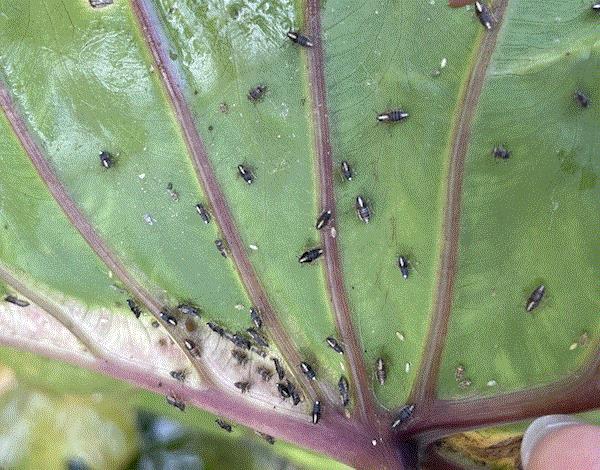
Fuerte herbicide is now available in California
OHP announced two weeks ago that its Fuerte herbicide has received registration approval in California. Growers can now purchase the herbicide from OHP’s local distributors.
Fuerte was first introduced in 2019. With California’s registration, Fuerte is now registered in all states and territories, except Puerto Rico.
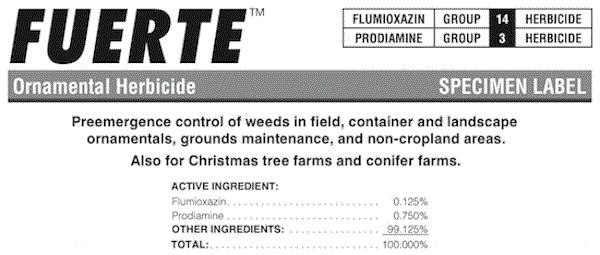
Fuerte (flumioxazin + prodiamine) is a granular pre-emergent herbicide and is registered for management of grassy and broadleaf weeds in field and container nurseries, landscapes, Christmas tree farms and conifer farms. The application rate is 100 pounds per acre, and is limited to two applications, three months apart, per year.
Read this newsletter from September 2019 for more discussion on the uses and research data on Fuerte. Click HERE for Fuerte’s Product Information Sheet for a list of sensitive plant species and other application precautions.
BioWorks introduces Product Compatibility Tool
I don’t tank mix pesticide, fertilizers and other chemical often, unless I absolutely have to. For example, when I have to deal with botrytis and aphids on the same crop. I realize I may be an odd ball in this regard. Lots of growers employ tank mix regularly.
If you tank mix products frequently, do you perform a “jar test” before mixing a full tank? You know, get a small jar, mix the products in water, shake it up and see if the two products mix well? If you see that mixing the two products creates colors that are more tie-dye than monochrome, clear layers, solids, bubbles, heat, or other crazy chemical or physical reactions, it’s probably not a good idea to mix them together. Incompatibility can also occur when one product reduces the efficacy of its tank-mix partner, even if no physical change in the mixture can be seen. Compatible products should mix well, with no odd appearance, or have no antagonistic effect. A failure to detect potential incompatibility between tank-mixed products not only results in failure to control the pest, it can also cause you the crop.
BioWorks has a new tool to help folks determine if other pest management products are compatible with BioWorks’ products. The Product Compatibility Tool is a free online tool where you can create a hypothetical scenario of mixing BioWorks’ products with other pesticides, adjuvants or fertilizers. These products can be selected from drop-down lists, and more than two products can be selected at the same time. The tool generates a table telling you if the selected pesticides or other products are compatible with BioWorks’ products.
I played with the tool a little bit just to see how it works. I selected BotryStop WP (which was recently introduced by BioWorks), Astun (a fungicide), and Azatin (an insecticide). I chose Astun and Azatin, well, because I was too lazy to go down the long list of available products. Not surprisingly, the compatibility tool told me that BotryStop isn’t compatible with Astun because Astun, as a fungicide, interferes with BotryStop, which is made of live fungal spores. There is no information on whether BotryStop is compatible with Azatin.
Click HERE to read a news release about BioWorks’ Product Compatibility Tool. Click HERE to access the tool.
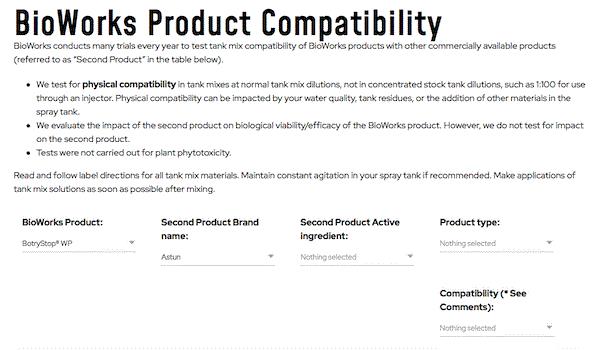
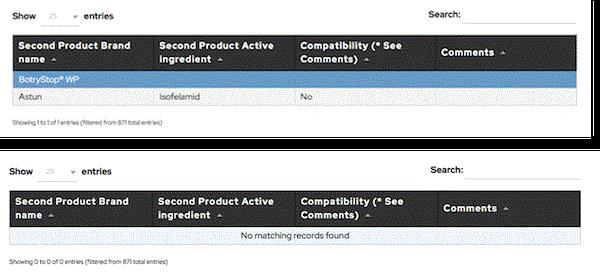
Diseases, IGRs and mites in GrowerTalks
The headliner of the April issue of GrowerTalks is about adaptation of technology in greenhouses. But the issue is also chock full of information on pest management.
Paul Pilon, our very own Editor-at-Large of Perennial Pulse, contributed an article on how to prevent a greenhouse turning from a plant factory to a disease factory. A lot of factors can help that transformation—contaminated plants, suitable temperature, high humidity, plant density, etc. Paul will tell you how to prevent disease outbreak in your greenhouse.
Ray Cloyd and Nathan Herrick of Kansas State University talked about insect and mite growth regulators—their modes of action, available products, target pests, direct and indirect effects on target pests, and compatibility with biological control. This is an article you don’t want to miss if you use insect and mite growth regulators in your operation.
I have an article on selecting the right miticides for your operation. There are several factors you need to consider when deciding which miticide is right for you at a certain time. These factors are mite species and life stages, contact or translaminar miticides, and compatibility with biological control agents. I explained why I think miticide selection isn’t simply reaching for what’s on the shelf. Holler at me on whether you agree or disagree with my opinions.
Lastly, and something that really interested me, is an article from Lance Osborne of the University of Florida and Zee Ahmed and Cindy McKenzie of USDA-ARS on banker plants for mites. This is one of a series of article on banker plants Lance, Zee and Cindy have published on GrowerTalks, and have a lot of information on how you can set up and use banker plants to control mites, particularly spider mites.

Thrips parvispinus has a website
I talked in January of this year about a new invasive thrips species, Thrips parvispinus, that’s causing all sorts of troubles for growers in Florida. Click HERE to read my newsletter about this invasive thrips species.
Ornamental plant and vegetable growers in central and southern Florida are struggling to manage this pest. This blog post from the University of Florida reported that a grower in south Florida lost an entire crop of peppers, worth $1.3 million, to the pest in November. Understandably, folks (not just in Florida but in other states) are nervous and researchers and Extension personnel in Florida jumped into action.
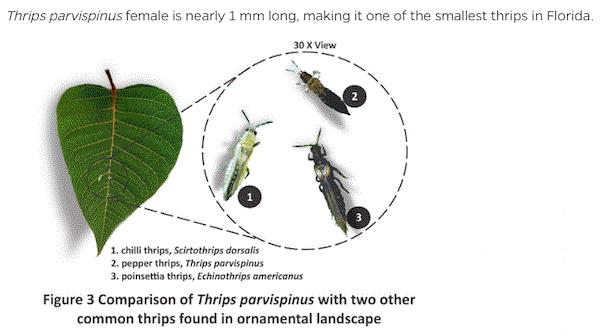 (Figure credit: Ahmed et al. 2023.)
(Figure credit: Ahmed et al. 2023.)
The aforementioned trio—Lance Osborne of the University of Florida and Zee Ahmed and Cindy McKenzie of USDA-ARS—joined forces with Alexandra Revynthi, also of the University of Florida, and published a new website on Thrips parvispinus. The website is updated regularly and contains lots of information on the biology and on monitoring, identifying and managing of this invasive thrips species. An excellent tool is a scouting sheet you can print out and put on a clip board for easy observation and recording during scouting. The scouting sheet has lots of pictures on thrips species that may be seen while scouting and their relative size to a pencil.
Currently, there are no insecticide recommendations on the website but I anticipate more updates down the road as research projects yield results. In the meantime, click HERE for my newsletter on what growers have reported as effective against this invasive thrips species.

Answer to "What the ... ?"
Aaron sent me the picture last Wednesday, when I was attending a flatheaded borer workshop in Tennessee. I could only give a tentative identification (“some kind of leafhopper”) at that time and promised to get to the bottom of this when I got back in the office. Aaron was kind enough to wait for the answer, which came, embarrassingly, almost a week later.
It wasn’t too hard to find out what the critter was. They are taro leafhopper, Tarophagus colocasiae. The white strip and dot seem to be good characteristics for identification.
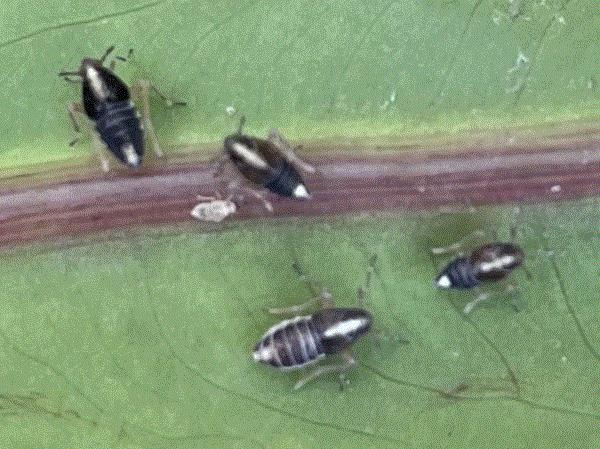
Never heard of a taro leafhopper? Neither have I! In fact, I have to do a double-take when I read the scientific name—Tarophagus means “taro-feeding” and colocasiae means “from Colocasia,” which is the plant genus that includes taro and elephant-ears. That’s way too straightforward for taxonomists, who loves to name their insects with all kind of mind-bending words of a dead language.
The taro leafhopper isn’t everywhere and doesn’t feed on everything, luckily. It’s a native of Southeast Asia and was first detected in the United States in a garden center in Winter Haven, Florida, in 2015. How did it get to Florida? It’s anyone’s guess but we know it’s spreading.
This leafhopper species seems to like plants in the Araceae family, such as Alocasia, Caladium, Colocasia, and Xanthosoma. These plants are used widely as landscape plants so the chance of the taro leafhopper to spread through the ornamental plant trade is high. Some even suggested using this leafhopper as a biological control agent against the escaped and invasive ornamental elephant-ears.
If you see these leafhoppers where you live, please report them to your local Extension offices. Find out more about the taro leafhopper in this Fact Sheet from the University of Florida.




See y’all later!

JC Chong
Professor of Entomology at Clemson University
This e-mail received by 27,847 subscribers like you!
If you're interested in advertising on PestTalks contact Kim Brown ASAP!